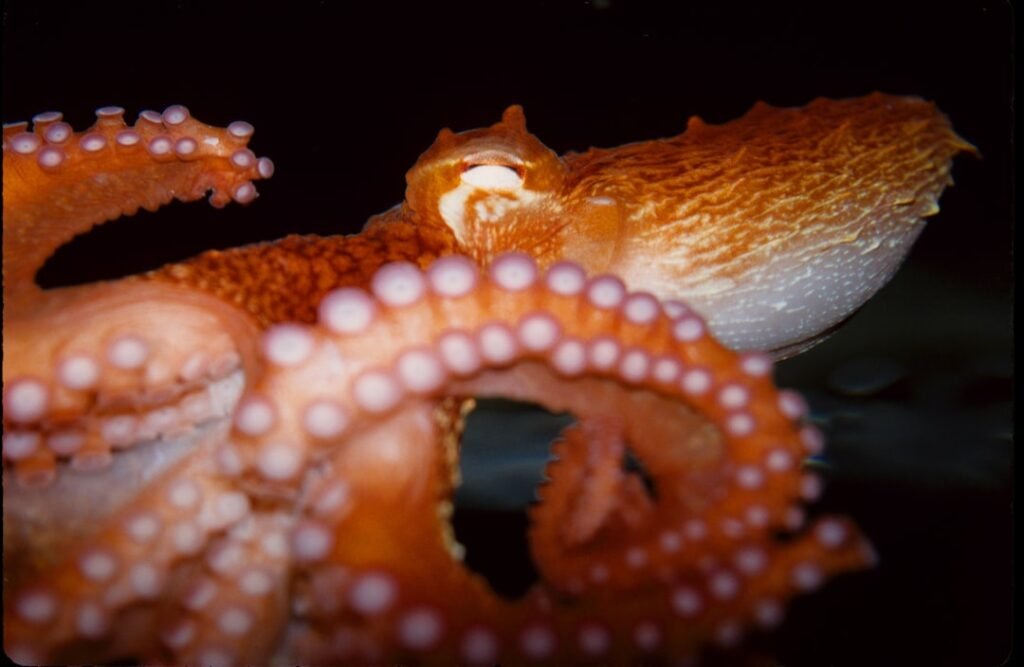Picture this: you’re deep beneath the waves, watching an octopus rest on the seafloor. Suddenly, its pale skin erupts in a cascade of vibrant colors, rippling like an underwater fireworks show. Is this mysterious creature lost in dreams of underwater adventures? The latest research suggests that what you’re witnessing might be far more extraordinary than you ever imagined. Scientists have uncovered compelling evidence that these intelligent invertebrates don’t just sleep – they may actually dream in ways that mirror our own nocturnal journeys.
Recent groundbreaking studies have revealed that octopuses experience sleep cycles remarkably similar to mammals, complete with what appears to be their own version of REM sleep. This discovery has profound implications for our understanding of consciousness and cognitive evolution in the animal kingdom.
The Discovery That Changed Everything

The journey to understanding octopus dreams began with a simple observation in laboratory tanks. Researchers filmed four octopuses of the species Octopus insularis, found off the coast of Brazil, while they slept in tanks in the lab. They checked whether the animals were awake or asleep by showing videos of live crabs on a screen facing their tank or gently hitting the tank wall with a rubber hammer to see whether they stirred.
What they discovered was revolutionary. A new study reveals that, like us, our eight-legged friends experience both an active and a quiet sleep stage. This finding challenged everything scientists thought they knew about invertebrate sleep patterns. Because humans and octopuses are separated by approximately 550-600 million years of evolution, the discovery suggests a two-stage sleep pattern evolved independently twice.
Two Distinct Sleep States Revealed

The study found that the quiet sleep state had pale skin, closed pupils, and longer episode durations, whereas the active sleep state had dynamic skin patterns with varying colors and textures, rapid eye movements, and shorter episode durations. An octopus’s active sleep cycle seems similar to the rapid-eye movement (REM) seen in other mammals.
An octopus is pale whiteish-gray all over during quiet sleep with eyes tightly shut and hardly moving. On average, this phase seems to last about 7 minutes. Active sleep is much shorter, lasting less than a minute, and is when the octopus puts on a sleepy show for anyone watching. The contrast between these two states is so dramatic that researchers initially questioned whether the animals were truly sleeping during the colorful episodes.
The Spectacular Color Show of Active Sleep

In the midst of an active sleep state, an octopus’s skin changes color and texture. Moving eyes, twitching muscles and squeezing suckers also mark this REM-like phase. These vivid displays aren’t random – they follow specific patterns that tell an incredible story about what’s happening in the octopus’s brain.
The chromatophores on the octopus’s head and mantle – the bulbous structure that houses the animal’s organs – display “sudden simultaneous darkening.” The animal then begins twitching, contracting its suckers, moving its eyes and increasing its ventilation rate. The octopus also expands and contracts its pupils, while vibrant colors wash over its whole body. Imagine if your thoughts while dreaming painted themselves across your skin for the world to see.
Neural Activity Mirrors Waking States

High-density electrophysiological recordings from the central brain reveal that the local field potential (LFP) activity during active sleep resembles that of waking. LFP activity differs across brain regions, with the strongest activity during active sleep seen in the superior frontal and vertical lobes, anatomically connected regions associated with learning and memory function.
The researchers also delved into the brain activity of the octopuses when awake and asleep. During quiet sleep, the scientists saw characteristic brain waves that closely resemble certain waveforms seen during non-REM sleep in mammalian brains called sleep spindles. Although the exact function of these waveforms is unclear even within humans, scientists believe they aid in consolidating memories. Using a cutting-edge microscope built by co-first author Dr. Tomoyuki Mano, the researchers determined that these sleep spindle-like waves occur in regions of the octopuses’ brains associated with learning and memory, suggesting that these waves potentially serve a similar function to humans.
Chromatophores as Windows to the Mind

AS skin patterns operate under direct neural control, thus providing a unique window into the contents of neural activity in the offline brain. This means that when an octopus displays those mesmerizing color patterns during sleep, we might literally be watching its dreams play out on its skin.
In organisms, the scales span the macroscopic – such as the octopus’s behavior in response to a predator – to the microscopic, such as the pigment granules inside cells involved in camouflage called chromatophores. “I like emergent phenomena. In an octopus, 100,000 chromatophores collectively coordinate to give rise to macroscopic behavior.” Think of chromatophores as tiny pixels on a biological screen, each one controlled by neural signals that create the larger picture.
Sleep Patterns Match Reptiles and Birds

These sudden bouts of movement and color occur periodically, at roughly 30- to 40-minute intervals. “It really resembles what you see in reptiles and birds: Long, quiet sleep followed by short, brief episodes of active sleep,” Ribeiro said. Mammalian sleep follows a similar pattern but the active sleep, namely REM, typically lasts longer than in other animals, he said.
Over the course of 12 hours, an octopus only sleeps, on average, a total of around 1 hour intermittently! Roughly 5 minutes out of these 2 hours is their active sleep (like our REM cycle) with the majority being quiet sleep. This brevity makes octopus active sleep episodes more like quick video clips rather than the feature-length films humans experience during REM sleep.
Evidence of Memory Consolidation

REM is thought to be a time when connections are made within the brain, getting rid of useless information while retaining helpful memories. It’s a time when short-term memories get converted into long-term memories. Is this when an octopus retains which rock crevices always seem to have a juicy crab meal waiting there? Or could it be when the satellite brains in their arms download their daily information to the main brain?
Another intriguing idea is that the octopuses could be re-living and learning from their waking experiences, such as hunting or hiding from a predator, and reactivating the skin pattern associated with each experience. Another intriguing idea is that the octopuses could be re-living and learning from their waking experiences, such as hunting or hiding from a predator, and reactivating the skin pattern associated with each experience. In other words, they could be doing something similar to dreaming.
Convergent Evolution of Complex Sleep

Other invertebrates, such as insects and worms, generally undergo a single sleep stage. “They just have one kind of sleep where the brain just kind of goes quiet,” says Reiter. This implies that octopuses have evolved two-stage sleep independently of vertebrates, which suggests that active sleep could be a “general feature of complex cognition,” says Meshulam.
Especially when you consider that humans and octopuses split approximately 550-600 million years ago along the evolutionary line but somehow managed to evolve similar sleeping patterns! This type of phenomenon is known as convergent evolution where animals evolve similar traits to pressures in their surroundings. Like how wings evolved on bugs, bats, and birds separately, but have the same purpose! This parallel evolution suggests that complex sleep might be essential for any brain capable of sophisticated cognition.
The Dream Question Remains

Study authors Sidarta Ribeiro and Sylvia Medeiros told CNN, “It is not possible to affirm that octopuses dream because they cannot tell us that, but our results suggest that during ‘Active sleep’ the octopus experiences a state analogous to REM sleep, which is the state during which humans dream the most.” The researchers added that if octopuses do dream, their dreams are most likely not like those of humans. “If octopuses indeed dream, it is unlikely that they experience complex symbolic plots like we do,” Ribeiro and Medeiros said. “‘Active sleep’ in the octopus has a very short duration (typically from a few seconds to one minute). If during this state there is any dreaming going on, it should be more like small videoclips, or even gifs.”
“In this sense, while humans can verbally report what kind of dreams they had only once they wake, the octopuses’ skin pattern acts as a visual readout of their brain activity during sleep,” said Prof. Reiter. He added, “We currently don’t know which of these explanations, if any, could be correct. We are very interested in investigating further.” The idea that we might one day decode octopus dreams by reading their skin patterns sounds like science fiction, yet it’s becoming a scientific possibility.
Conclusion

The discovery that octopuses experience two-stage sleep cycles similar to our own represents a paradigm shift in how we understand consciousness and cognition in the animal kingdom. These findings suggest that complex sleep patterns may be fundamental requirements for any sufficiently advanced nervous system, regardless of whether it evolved in vertebrates or invertebrates.
While we may never know for certain what octopuses dream about during those brief, colorful episodes, the evidence increasingly points to rich inner experiences occurring beneath the waves. Perhaps they dream of perfect camouflage, successful hunts, or escaping from predators – their skin telling stories we’re only beginning to learn how to read. What do you think octopuses might dream about in their underwater world? The answer could revolutionize our understanding of consciousness itself.

Jan loves Wildlife and Animals and is one of the founders of Animals Around The Globe. He holds an MSc in Finance & Economics and is a passionate PADI Open Water Diver. His favorite animals are Mountain Gorillas, Tigers, and Great White Sharks. He lived in South Africa, Germany, the USA, Ireland, Italy, China, and Australia. Before AATG, Jan worked for Google, Axel Springer, BMW and others.




